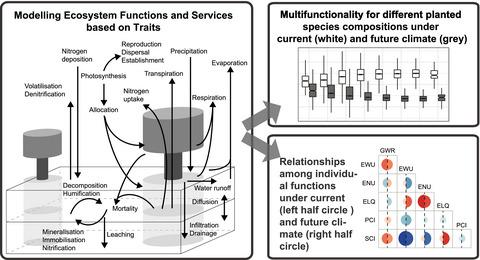当前位置:
X-MOL 学术
›
J. Appl. Ecol.
›
论文详情
Our official English website, www.x-mol.net, welcomes your
feedback! (Note: you will need to create a separate account there.)
Global change shifts trade-offs among ecosystem functions in woodlands restored for multifunctionality
Journal of Applied Ecology ( IF 5.0 ) Pub Date : 2021-05-03 , DOI: 10.1111/1365-2664.13900 Sebastian Fiedler 1, 2, 3 , José A. F. Monteiro 1, 2, 4 , Kristin B. Hulvey 5 , Rachel J. Standish 6 , Michael P. Perring 7, 8, 9 , Britta Tietjen 1, 2
中文翻译:

全球变化改变了恢复多功能的林地生态系统功能之间的权衡
更新日期:2021-05-03
Journal of Applied Ecology ( IF 5.0 ) Pub Date : 2021-05-03 , DOI: 10.1111/1365-2664.13900 Sebastian Fiedler 1, 2, 3 , José A. F. Monteiro 1, 2, 4 , Kristin B. Hulvey 5 , Rachel J. Standish 6 , Michael P. Perring 7, 8, 9 , Britta Tietjen 1, 2
Affiliation

|
- Ecological restoration increasingly aims at improving ecosystem multifunctionality and making landscapes resilient to future threats, especially in biodiversity hotspots such as Mediterranean-type ecosystems. Plants and their traits play a major role in the functioning of an ecosystem. Therefore, successful restoration towards long-term multifunctionality requires a fundamental mechanistic understanding of this link under changing climate. An integrated approach of empirical research and simulation modelling with a focus on plant traits can allow this understanding.
- Based on empirical data from a large-scale restoration project in a Mediterranean-type ecosystem in Western Australia, we developed and validated the spatially explicit simulation model Modelling Ecosystem Functions and Services based on Traits (ModEST), which calculates coupled dynamics of nutrients, water and individual plants characterised by functional traits. We then simulated all possible combinations of eight plant species with different levels of diversity to assess the role of plant diversity and traits on multifunctionality, the provision of six ecosystem functions that can be linked to ecosystem services, as well as trade-offs and synergies among the functions under current and future climatic conditions.
- Our results show that multifunctionality cannot fully be achieved because of trade-offs among functions that are attributable to sets of traits that affect functions differently. Our measure of multifunctionality was increased by higher levels of planted species richness under current, but not future climatic conditions. In contrast, single functions were differently impacted by increased plant diversity and thus the choice and weighting of these functions affected multifunctionality. In addition, we found that trade-offs and synergies among functions shifted with climate change due to different direct and indirect (mediated via community trait changes) effects of climate change on functions.
- Synthesis and application. With our simulation model Modelling Ecosystem Functions and Services based on Traits (ModEST), we show that restoration towards multifunctionality might be challenging not only under current conditions but also in the long-term. However, once ModEST is parameterised and validated for a specific restoration site, managers can assess which target goals can be achieved given the set of available plant species and site-specific conditions. It can also highlight which species combinations can best achieve long-term improved multifunctionality due to their trait diversity.
中文翻译:

全球变化改变了恢复多功能的林地生态系统功能之间的权衡
- 生态恢复越来越旨在提高生态系统的多功能性,并使景观能够抵御未来的威胁,尤其是在地中海型生态系统等生物多样性热点地区。植物及其特征在生态系统的功能中起着重要作用。因此,成功恢复长期多功能性需要对气候变化下的这种联系有基本的机制理解。以植物性状为重点的实证研究和模拟建模的综合方法可以实现这种理解。
- 基于来自西澳大利亚地中海型生态系统大规模恢复项目的经验数据,我们开发并验证了空间显性模拟模型Modeling Ecosystem Functions and Services based (ModEST),该模型计算养分、水的耦合动力学和具有功能性状特征的单株植物。然后,我们模拟了具有不同多样性水平的 8 种植物物种的所有可能组合,以评估植物多样性和性状对多功能性的作用、提供与生态系统服务相关的六种生态系统功能,以及之间的权衡和协同作用。当前和未来气候条件下的功能。
- 我们的结果表明,多功能性无法完全实现,因为功能之间的权衡可归因于对功能产生不同影响的特征集。在当前而非未来的气候条件下,我们对多功能性的衡量因更高水平的种植物种丰富度而增加。相比之下,单一功能受到植物多样性增加的不同影响,因此这些功能的选择和权重会影响多功能性。此外,我们发现由于气候变化对功能的不同直接和间接(通过群落特征变化介导)影响,功能之间的权衡和协同作用随着气候变化而变化。
- 合成与应用。通过我们的模拟模型,基于特征的生态系统功能和服务建模(ModEST),我们表明,恢复多功能性不仅在当前条件下而且在长期内都可能具有挑战性。然而,一旦 ModEST 被参数化并针对特定恢复地点进行验证,管理人员就可以评估在给定一组可用植物物种和特定地点条件的情况下可以实现哪些目标目标。它还可以突出显示哪些物种组合由于其性状多样性可以最好地实现长期改进的多功能性。











































 京公网安备 11010802027423号
京公网安备 11010802027423号